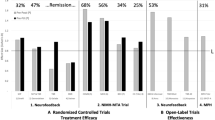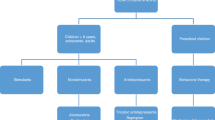Abstract
Current research has shown that neurofeedback, or EEG biofeedback as it is sometimes called, is a viable alternative treatment for Attention Deficit Hyperactivity Disorder (ADHD). The aim of this article is to illustrate current treatment modalities(s), compare them to neurofeedback, and present the benefits of utilizing this method of treatment to control and potentially alleviate the symptoms of ADHD. In addition, this article examines the prevalence rates and possible etiology of ADHD, the factors associated with ADHD and brain dysfunction, the current pharmacological treatments of ADHD, Ritalin, and the potential risks and side effects. Behavior modification and cognitive behavioral treatment for ADHD is discussed as well. Lastly, a brief history of the study of neurofeedback, treatment successes and clinical benefits, comparisons to medication, and limitations are presented.
Similar content being viewed by others
References
Ackerman, P., Dykman, R., Oglesby, D., & Newton, J. (1994). EEG power spectra of children with dyslexia, slow learners, and normally reading children with ADD during verbal processing. Journal of Learning Disabilities, 27, 619–630.
Ackerman, P., Dykman, R., Oglesby, D., & Newton, J. (1995). EEG power spectra of dysphonetic and nondysphonetic poor readers. Brain Language, 49, 140–152.
Amen, D. G., Paldi, J. H., & Thisted, R. A. (1993). Evaluating ADHD with brain SPECT imaging. Journal of the American Academy of Child and Adolescent Psychiatry, 32, 1080–1081.
American Psychiatric Association. (2000). Diagnostic and statistical manual of mental disorders (4th ed., text revision). Washington, DC: Author.
Barabasz, M. (1987). Tricotillomania: A new treatment. International Journal of Clinical and Experimental Hypnosis, 35, 146–154.
Barkley, R. A. (1990). Attention deficit hyperactivity disorder: A handbook for diagnosis and treatment. New York: Guildford.
Barkley, R. A. (1998). Attention-deficit hyperactivity disorder: A handbook of diagnosis and treatment (2nd ed.). New York: Guilford.
Bellak, L., & Black, R. (1992). Attention-deficit hyperactive disorder in adults. Clinical Therapeutics, 14, 138–147.
Bennett, F. C., Brown, R. T., Craver, J., & Anderson, D. (1999). Stimulant medication for the child with attention-deficit/hyperactivity disorder. Pediatric Clinics of North America, 46, 929–943.
Bradley, C. (1937). The behavior of children receiving benzotropine. American Journal of Psychiatry, 94, 577–585.
Brown, R. T., & Sawyer, M. (1988). Medication for school-aged children: Effects on learning and behavior. New York: Guilford.
Brownell, M., & Yogendran, M. (2001). Attention deficit hyperactivity disorder in Manitoba children: Medical diagnosis and psychostimulant treatment rates. Canadian Journal of Psychiatry, 6, 264–272.
Cantwell, D. (1996). Attention deficit disorder: A review of the past 10 years. Journal of American Academy of Child and Adolescent Psychiatry, 35, 978–987.
Chabot, R. A., Merkin, H., Wood, L. M., Davenport, T. L., & Serfontein, G. (1996). Sensitivity and specificity of QEEG in children with attention deficit or specific developmental learning disorders. Clinical Electroencephalography, 27, 26–34.
Chabot, R. A., & Serfontein, G. (1996). Quantitative electroencephalographic profiles of children with attention deficit disorder. Biological Psychiatry, 40, 951–963.
Chartier, G., & Kelly, N. (1991, August). Neurofeedback treatment of attention deficit-hyperactivity disorder. Grand Rounds Presentation, Rex Hospital, Raleigh, NC.
Clarke, A. R., Barry, R. J., McCarthy, R., & Selikowitz, M. (1998). EEG analysis in Attention-Deficit/Hyperactivity Disorder: A comparative study of two subtypes. Psychiatry Research, 81(1), 19–29.
Clarke, A. R., Barry, R. J., McCarthy, R., & Selikowitz, M. (2001a). Age and sex effects in the EEG: Differences in two subtypes of attention-deficit/hyperactivity disorder. Clinical Neurophysiology, 112(5), 815–826,
Clarke, A. R., Barry, R. J., McCarthy, R., Selikowitz, M., & Brown, C. R. (2002b). EEG differences in two subtypes of attention-deficit/hyperactivity disorder. Psychophysiology, 38(2), 212–221.
Clarke, A. R., Barry, R. J., McCarthy, R., Selikowitz, M., & Brown, C. R. (2002). EEG evidence for a new conceptualisation of attention deficit hyperactivity disorder. Clinical Neurophysiology, 113(7) 1036–1044.
Conte, R. (1991). Attention disorders. In B. Wong (Ed.), Learning about learning disabilities. New York: Academic Press.
David, O. (1974). Association between lower lead concentrations and hyperactivity in children. Environmental Health Perspectives, 7, 17–25.
Elia, J., Ambrosini, P. J., & Rapoport, J. L. (1999). Treatment of attention-deficit-hyperactivity disorder. New England Journal of Medicine, 340, 780–788.
Feingold, B. (1973). Food additives and child development. Hospital Practice, 8, 11–21.
Feingold, B. (1975). Why your child is hyperactive. New York: Random House.
Firestone, P., Kelly, M. J., Goodman, J. T., & Davey, J. (1981). Differential aspects of parent training and stimulant medication with hyperactives. Journal of the American Academy of Child Psychiatry, 20 135–147.
Fuchs, D., Mock, D., Morgan, P. L., & Young, C. L. (2003). Responsiveness-to-intervention: Definitions, evidence, and implications for the learning disabilities construct. Learning Disabilities Research & Practice, 18, 157–172.
Gaddes, W. H., & Edgell, D. (1994). Learning disabilities and brain function. New York: Springer-Verlag.
Goldstein, S., & Goldstein, M. (1990). Managing attention disorders in children: A guide for practitioners. New York: Wiley.
Hynd, G. W. Hem, K. L., Voeller, K. K., & Marshall, R. M. (1991). Neurobiological basis of attention-deficit hyperactivity disorder (ADHD). School Psychological Review 20, 174–186.
Linden, M., Habib, T., & Radojevic, J. (1996). A controlled study of the effects of EEG biofeedback on cognition and behavior of children with attention deficit disorder and learning disabilities. Biofeedback and Self Regulation, 2, 35–49.
Lubar, J. F. (1991). Discourse on the development of EEG diagnostics and biofeedback for attention-deficit/hyperactivity disorders. Biofeedback and Self-Regulation, 16, 201–224.
Lubar, J. F. (1995). Neurofeedback for the management of attention-deficit/hyperactivity disorder. In M. S. Schwartz & Associates (Eds.), Biofeedback: A practitioner's guide (2nd ed., pp. 493–522). New York: Guildford Press.
Lubar, J. F., & Shouse, M. N. (1976). EEG and behavioral changes in a hyperkinetic child concurrent with training of the sensorimotor rhythm (SMR): A preliminary report. Biofeedback and Self-Regulation, 3, 293–306.
Mann, C. A., Lubar, J. F., Zimmerman, A. W., Miller, C. A., & Muenchen, R. A. (1992). Quantitative analysis of EEG in boys with attention deficit hyperactivity disorder: Controlled study with clinical implications. Pediatric Neurology, 8, 30–36.
Marshall, P. (1989). Attention deficit disorder and allergy: A neurochemical model of the relation between the illness. Psychological Bulletin, 106, 434–446.
McCarney, S. B. (1995). Attention Deficit Disorders Evaluation Scale. Columbia, MO: Hawthorne Press.
Monastra, V. J., Monastra, D. M., & George, S. (2002). The effects of stimulant therapy, EEG biofeedback, and parenting style on the primary symptoms of attention-deficit/hyperactivity disorder. Applied Psychophysiology and Biofeedback, 27, 231–249.
National Institute of Health. (1998). Consensus statement on the diagnosis and treatment of attention-deficit/hyperactivity disorder. Bethesda, MD: Author.
Rossieter, T. R., & LaVaque, T. J. (1995). A comparison of EEG biofeedback and psychostimulants in treating attention deficit/hyperactivity disorders. Journal of Neurotherapy, 1, 48–59.
Satterfield, J., Cantwell, D., Lesser, M., & Podosin, R. (1972). Physiological studies of the hyperkinetic kid. American Journal of Psychiatry, 128, 103–108.
Solanto, M. V. (1998). Neuropsychopharmacological mechanisms of stimulant drug action in attention-deficit hyperactivity disorder: A review and integration. Behavioral Brain Research, 94(1), 127–152.
Spencer, T., Biederman, J., & Wilens, T. (1999). Attention-deficit/hyperactivity disorder and comorbidity. Pediatric Clinics of North America, 46, 915–944.
Swanson, J., McBurnett, T., Wigal, T., Pfiffner, L., Lerner, M., Williams, L., et al. (1993). Effect of stimulant medication on children with attention deficit disorder: A “review of reviews.” Exceptional Children, 60, 154–162.
Tansey, M. A. (1993). Ten-year stability of EEG biofeedback results for a hyperactive boy who failed fourth grade perceptually impaired class. Biofeedback and Self Regulation, 18, 33–44.
The MTA Cooperative Group. (1999). A 14-month randomized clinical trial of treatment strategies for attention-deficit/hyperactivity disorder. Archives of General Psychiatry, 56, 1073–1086.
Thompson, L., & Thompson, M. (1998). Neurofeedback combined with training in metacognitive strategies: Effectiveness in students with ADD. Applied Psychophysiology and Biofeedback, 23(4), 243–2463.
Volkow, N. D., Wang, G. J., Fowler, J. S., Logan, J., Gerasimov, M., Maynard, L., et al. (2001). Therapeutic doses of oral methylphenidate significantly increase extracellular dopamine in the human brain. Journal of Neuroscience, 21, 1–5.
Weiss, G., & Hechtnian, L. T. (1993). Hyperactive children grown up: ADHD in children, adolescents, and adults (2nd ed.). New York: Guilford.
Whalen, C. K., & Henker, B. (1991). Therapies for hyperactive children: Comparisons, combinations, and compromises. Journal of Consulting and Clinical Psychology, 59, 126–137.
Zametkin, A. J., & Rapoport, J. L. (1987). Noradrenergic hypothesis of attention-deficit disorder with hyperactivity: A critical review. In H. V. Metsler (Ed.), Psychopharmacology: The third generation of progress (pp. 837–842). New York: Raven Press.
Author information
Authors and Affiliations
Corresponding author
Rights and permissions
About this article
Cite this article
Fox, D.J., Tharp, D.F. & Fox, L.C. Neurofeedback: An Alternative and Efficacious Treatment for Attention Deficit Hyperactivity Disorder. Appl Psychophysiol Biofeedback 30, 365–373 (2005). https://doi.org/10.1007/s10484-005-8422-3
Issue Date:
DOI: https://doi.org/10.1007/s10484-005-8422-3




